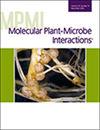Damaris Barminga, Sylvia Mutinda, Fredrick M Mobegi, Willy Kibet, Brett Hale, Sylvester Anami, Asela Wijeratne, Emily S Bellis, Steven Runo
求助PDF
{"title":"寄生植物(Striga)细胞壁动力学与水稻病理系统。","authors":"Damaris Barminga, Sylvia Mutinda, Fredrick M Mobegi, Willy Kibet, Brett Hale, Sylvester Anami, Asela Wijeratne, Emily S Bellis, Steven Runo","doi":"10.1094/MPMI-06-24-0064-FI","DOIUrl":null,"url":null,"abstract":"<p><p>In the plant-plant pathosystem of rice (<i>Oryza sativa</i>) and the parasitic plant <i>Striga hermonthica</i>, cell walls from either plant are important defensive and offensive structures. Here, we reveal the cell wall dynamics in both <i>Striga</i> and rice using simultaneous RNA sequencing. We used weighted gene co-expression network analysis to home in on cell wall modification processes occurring in interactions with a resistant rice cultivar (Nipponbare) compared with a susceptible one (IAC 165). Likewise, we compared the cell wall dynamics in <i>Striga</i> infecting resistant and susceptible rice. Our study revealed an intense battlement at the <i>Striga-</i>rice cell walls involving both parasite (offense) and host (defense) factors, the outcome of which makes the difference between successful or failed parasitism. <i>Striga</i> activates genes encoding cell wall-degrading enzymes to gain access to the host, expansins to allow for cell elongation, and pectin methyl esterase inhibitors for rigidity during infection. In the susceptible host, immune response processes are not induced, and <i>Striga</i>-derived cell wall-degrading enzymes easily breach the host cell wall, resulting in successful parasitism. In contrast, the resistant host invokes immune responses modulated by phytohormones to fortify the cell wall through polysaccharides and lignin deposition. Through these processes, the cell wall of the resistant host successfully obstructs parasite entry. We discuss the implications of these findings in the context of practical agriculture in which cell wall modification can be used to manage parasitic plants. [Formula: see text] Copyright © 2025 The Author(s). This is an open access article distributed under the CC BY-NC-ND 4.0 International license.</p>","PeriodicalId":19009,"journal":{"name":"Molecular Plant-microbe Interactions","volume":" ","pages":"285-296"},"PeriodicalIF":3.4000,"publicationDate":"2025-03-01","publicationTypes":"Journal Article","fieldsOfStudy":null,"isOpenAccess":false,"openAccessPdf":"","citationCount":"0","resultStr":"{\"title\":\"Cell Wall Dynamics in the Parasitic Plant (<i>Striga</i>) and Rice Pathosystem.\",\"authors\":\"Damaris Barminga, Sylvia Mutinda, Fredrick M Mobegi, Willy Kibet, Brett Hale, Sylvester Anami, Asela Wijeratne, Emily S Bellis, Steven Runo\",\"doi\":\"10.1094/MPMI-06-24-0064-FI\",\"DOIUrl\":null,\"url\":null,\"abstract\":\"<p><p>In the plant-plant pathosystem of rice (<i>Oryza sativa</i>) and the parasitic plant <i>Striga hermonthica</i>, cell walls from either plant are important defensive and offensive structures. Here, we reveal the cell wall dynamics in both <i>Striga</i> and rice using simultaneous RNA sequencing. We used weighted gene co-expression network analysis to home in on cell wall modification processes occurring in interactions with a resistant rice cultivar (Nipponbare) compared with a susceptible one (IAC 165). Likewise, we compared the cell wall dynamics in <i>Striga</i> infecting resistant and susceptible rice. Our study revealed an intense battlement at the <i>Striga-</i>rice cell walls involving both parasite (offense) and host (defense) factors, the outcome of which makes the difference between successful or failed parasitism. <i>Striga</i> activates genes encoding cell wall-degrading enzymes to gain access to the host, expansins to allow for cell elongation, and pectin methyl esterase inhibitors for rigidity during infection. In the susceptible host, immune response processes are not induced, and <i>Striga</i>-derived cell wall-degrading enzymes easily breach the host cell wall, resulting in successful parasitism. In contrast, the resistant host invokes immune responses modulated by phytohormones to fortify the cell wall through polysaccharides and lignin deposition. Through these processes, the cell wall of the resistant host successfully obstructs parasite entry. We discuss the implications of these findings in the context of practical agriculture in which cell wall modification can be used to manage parasitic plants. [Formula: see text] Copyright © 2025 The Author(s). This is an open access article distributed under the CC BY-NC-ND 4.0 International license.</p>\",\"PeriodicalId\":19009,\"journal\":{\"name\":\"Molecular Plant-microbe Interactions\",\"volume\":\" \",\"pages\":\"285-296\"},\"PeriodicalIF\":3.4000,\"publicationDate\":\"2025-03-01\",\"publicationTypes\":\"Journal Article\",\"fieldsOfStudy\":null,\"isOpenAccess\":false,\"openAccessPdf\":\"\",\"citationCount\":\"0\",\"resultStr\":null,\"platform\":\"Semanticscholar\",\"paperid\":null,\"PeriodicalName\":\"Molecular Plant-microbe Interactions\",\"FirstCategoryId\":\"99\",\"ListUrlMain\":\"https://doi.org/10.1094/MPMI-06-24-0064-FI\",\"RegionNum\":3,\"RegionCategory\":\"生物学\",\"ArticlePicture\":[],\"TitleCN\":null,\"AbstractTextCN\":null,\"PMCID\":null,\"EPubDate\":\"2025/4/14 0:00:00\",\"PubModel\":\"Epub\",\"JCR\":\"Q2\",\"JCRName\":\"BIOCHEMISTRY & MOLECULAR BIOLOGY\",\"Score\":null,\"Total\":0}","platform":"Semanticscholar","paperid":null,"PeriodicalName":"Molecular Plant-microbe Interactions","FirstCategoryId":"99","ListUrlMain":"https://doi.org/10.1094/MPMI-06-24-0064-FI","RegionNum":3,"RegionCategory":"生物学","ArticlePicture":[],"TitleCN":null,"AbstractTextCN":null,"PMCID":null,"EPubDate":"2025/4/14 0:00:00","PubModel":"Epub","JCR":"Q2","JCRName":"BIOCHEMISTRY & MOLECULAR BIOLOGY","Score":null,"Total":0}
引用次数: 0
引用
批量引用

 求助内容:
求助内容: 应助结果提醒方式:
应助结果提醒方式:


